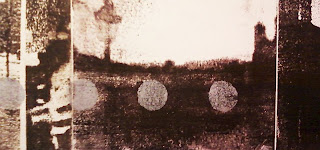This studio visit, I began working in earnest on overprinting images onto the pages of the 100 page accordion book. During the last week, I made about 20 fine pen contour drawings from photos of Lucerne. I went to Kinko's to use their Xerox machine to make enlargements of the drawings, up to 800%. In addition to the drawings, I accidentally photocopied a page from my desk diary. This produced an interesting abstract pattern of lines and holes that I decided to incorporate into the prints.
This is how the studio looked with everything ready to print:
On the right is the accordion book, ready to be printed on again. In the middle are all the photocopies. On the left are the piles of paper to aid in hand-printing, blotting, and interleaving between the newly-printed pages.
I'm doing all the overprints using the same paper-litho transfer process as the first layer of prints, but in silver ink instead of sanguine-black. The abstract dot pattern came out like this:
And here is an example of the patterns produced by those 800% enlargements:
This combination of prints based on 'damaged photos' and drawings is something I did a lot of when I made all those print-sculpture combinations with cigar boxes (link to album here). I like the combination of mysterious, solid masses in the first layer, then the linear but still slightly unclear addition of the second layer.
 Subscribe to Praeterita in a reader
Subscribe to Praeterita in a reader
This is how the studio looked with everything ready to print:
On the right is the accordion book, ready to be printed on again. In the middle are all the photocopies. On the left are the piles of paper to aid in hand-printing, blotting, and interleaving between the newly-printed pages.
I'm doing all the overprints using the same paper-litho transfer process as the first layer of prints, but in silver ink instead of sanguine-black. The abstract dot pattern came out like this:
And here is an example of the patterns produced by those 800% enlargements:
This combination of prints based on 'damaged photos' and drawings is something I did a lot of when I made all those print-sculpture combinations with cigar boxes (link to album here). I like the combination of mysterious, solid masses in the first layer, then the linear but still slightly unclear addition of the second layer.


